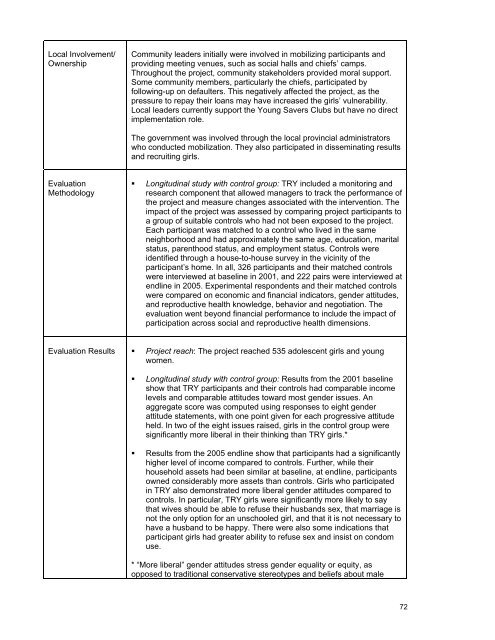Implementing Multiple Gender Strategies to Improve HIV and ... - ICRW
Implementing Multiple Gender Strategies to Improve HIV and ... - ICRW
Implementing Multiple Gender Strategies to Improve HIV and ... - ICRW
You also want an ePaper? Increase the reach of your titles
YUMPU automatically turns print PDFs into web optimized ePapers that Google loves.
Local Involvement/<br />
Ownership<br />
Community leaders initially were involved in mobilizing participants <strong>and</strong><br />
providing meeting venues, such as social halls <strong>and</strong> chiefs’ camps.<br />
Throughout the project, community stakeholders provided moral support.<br />
Some community members, particularly the chiefs, participated by<br />
following-up on defaulters. This negatively affected the project, as the<br />
pressure <strong>to</strong> repay their loans may have increased the girls’ vulnerability.<br />
Local leaders currently support the Young Savers Clubs but have no direct<br />
implementation role.<br />
The government was involved through the local provincial administra<strong>to</strong>rs<br />
who conducted mobilization. They also participated in disseminating results<br />
<strong>and</strong> recruiting girls.<br />
Evaluation<br />
Methodology<br />
• Longitudinal study with control group: TRY included a moni<strong>to</strong>ring <strong>and</strong><br />
research component that allowed managers <strong>to</strong> track the performance of<br />
the project <strong>and</strong> measure changes associated with the intervention. The<br />
impact of the project was assessed by comparing project participants <strong>to</strong><br />
a group of suitable controls who had not been exposed <strong>to</strong> the project.<br />
Each participant was matched <strong>to</strong> a control who lived in the same<br />
neighborhood <strong>and</strong> had approximately the same age, education, marital<br />
status, parenthood status, <strong>and</strong> employment status. Controls were<br />
identified through a house-<strong>to</strong>-house survey in the vicinity of the<br />
participant’s home. In all, 326 participants <strong>and</strong> their matched controls<br />
were interviewed at baseline in 2001, <strong>and</strong> 222 pairs were interviewed at<br />
endline in 2005. Experimental respondents <strong>and</strong> their matched controls<br />
were compared on economic <strong>and</strong> financial indica<strong>to</strong>rs, gender attitudes,<br />
<strong>and</strong> reproductive health knowledge, behavior <strong>and</strong> negotiation. The<br />
evaluation went beyond financial performance <strong>to</strong> include the impact of<br />
participation across social <strong>and</strong> reproductive health dimensions.<br />
Evaluation Results • Project reach: The project reached 535 adolescent girls <strong>and</strong> young<br />
women.<br />
• Longitudinal study with control group: Results from the 2001 baseline<br />
show that TRY participants <strong>and</strong> their controls had comparable income<br />
levels <strong>and</strong> comparable attitudes <strong>to</strong>ward most gender issues. An<br />
aggregate score was computed using responses <strong>to</strong> eight gender<br />
attitude statements, with one point given for each progressive attitude<br />
held. In two of the eight issues raised, girls in the control group were<br />
significantly more liberal in their thinking than TRY girls.*<br />
• Results from the 2005 endline show that participants had a significantly<br />
higher level of income compared <strong>to</strong> controls. Further, while their<br />
household assets had been similar at baseline, at endline, participants<br />
owned considerably more assets than controls. Girls who participated<br />
in TRY also demonstrated more liberal gender attitudes compared <strong>to</strong><br />
controls. In particular, TRY girls were significantly more likely <strong>to</strong> say<br />
that wives should be able <strong>to</strong> refuse their husb<strong>and</strong>s sex, that marriage is<br />
not the only option for an unschooled girl, <strong>and</strong> that it is not necessary <strong>to</strong><br />
have a husb<strong>and</strong> <strong>to</strong> be happy. There were also some indications that<br />
participant girls had greater ability <strong>to</strong> refuse sex <strong>and</strong> insist on condom<br />
use.<br />
* “More liberal” gender attitudes stress gender equality or equity, as<br />
opposed <strong>to</strong> traditional conservative stereotypes <strong>and</strong> beliefs about male<br />
72
















